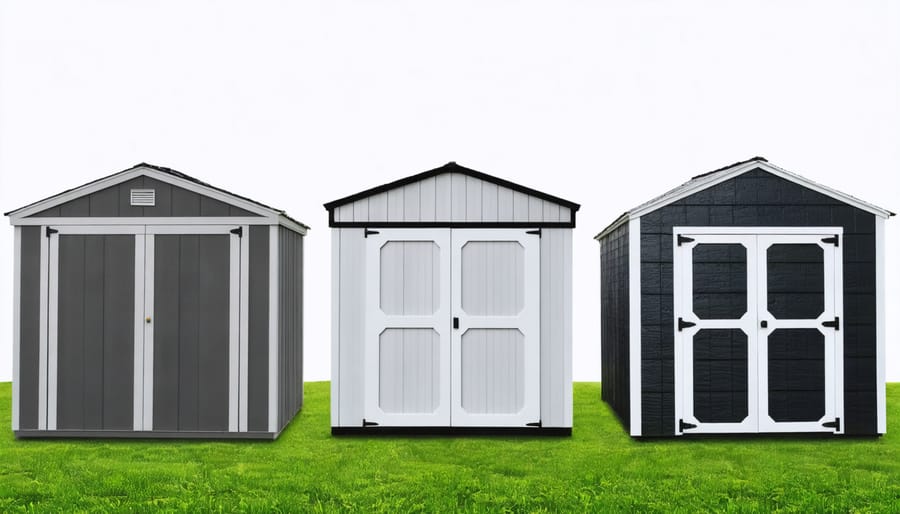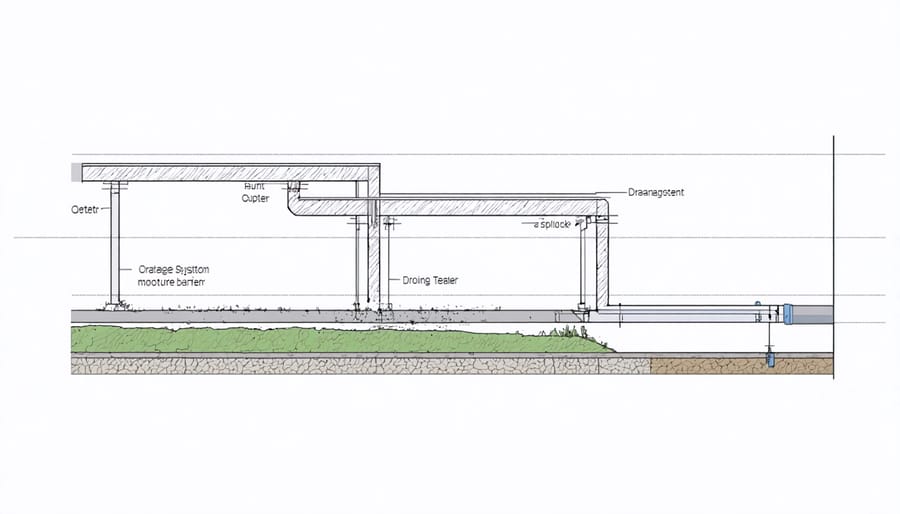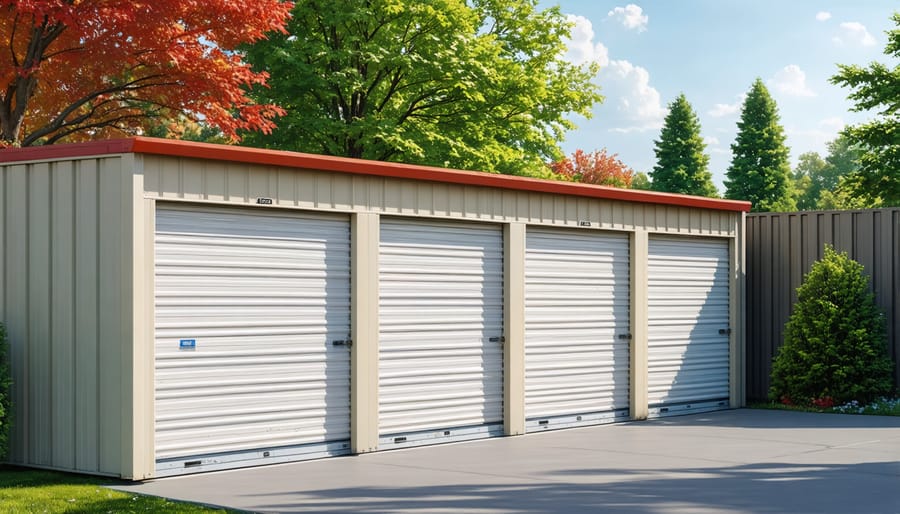How to Keep Your Outdoor Storage Safe in Any Weather (Expert Solutions)

Transform your outdoor storage from a weather-vulnerable weakness into a fortress against the elements with smart material choices and strategic design. Weather-resistant outdoor storage combines robust construction with intelligent features to protect everything from garden tools to seasonal decorations from rain, snow, UV damage, and temperature fluctuations. Modern solutions range from heavy-duty plastic deck boxes to professionally engineered metal sheds, each offering unique benefits for specific storage needs and climate challenges.
Select storage units featuring double-wall construction, integrated weather stripping, and raised floors to prevent moisture seepage and ensure year-round protection. The best outdoor storage solutions incorporate UV-resistant materials, powder-coated metals, or treated woods that withstand harsh sunlight and extreme temperatures without warping, rusting, or degrading. These purposefully designed features work together to create a reliable shield against nature’s most challenging conditions.
Remember that proper placement and installation play crucial roles in maximizing weather resistance. Position storage units on level, well-draining surfaces, away from overhanging branches and areas prone to water accumulation. This strategic approach to outdoor storage not only protects your valuables but also maintains your property’s aesthetic appeal while providing peace of mind during severe weather events.
Smart Material Choices for Weather-Proof Storage
Metal vs. Vinyl vs. Resin: Making the Right Choice
When choosing an outdoor storage solution, the material you select plays a crucial role in protecting your belongings from the elements. Each option brings its own set of advantages and considerations to the table.
Metal storage units offer outstanding durability and security. Steel and aluminum structures resist rust when properly treated and can withstand heavy snow loads and strong winds. They’re also fire-resistant and typically the most budget-friendly option. However, they can become hot in summer and may develop condensation without proper ventilation.
Vinyl (or PVC) storage solutions have become increasingly popular due to their maintenance-free nature. They never need painting, won’t rust or rot, and clean up easily with just soap and water. While generally more expensive than metal, vinyl storage units resist fading and maintain their appearance for years. The main drawback is they may become brittle in extreme cold.
Resin storage units combine the best qualities of both materials. Modern resin compounds are engineered to withstand UV rays, preventing fading and deterioration. They’re lightweight yet sturdy, and many feature reinforced floors for heavy items. While typically the most expensive option, resin storage units offer excellent weather resistance and require minimal maintenance. They also tend to have the most contemporary designs, blending well with modern home aesthetics.
Consider your climate, budget, and aesthetic preferences when making your choice. For areas with extreme weather, resin or heavy-duty metal might be your best bet, while vinyl works wonderfully in moderate climates.

Weatherproof Seals and Barriers
The first line of defense for your outdoor storage unit lies in its weather-resistant barriers and sealing systems. Quality weatherproofing starts at the foundation with proper moisture barriers and extends all the way to the roof’s edge. A well-designed drip edge system prevents water from seeping under the roofline, while flexible rubber or silicone gaskets around doors and windows create watertight seals that stand up to driving rain and snow.
Pay special attention to corners and joints, as these are common entry points for moisture. Modern weatherstripping materials, like EPDM rubber or vinyl-coated foam, provide excellent protection while maintaining their flexibility in extreme temperatures. For added protection, consider installing door sweeps at the bottom of entry points and ensuring all ventilation openings are properly screened and baffled.
Gap sealants and caulking compounds designed specifically for outdoor use should be applied wherever different materials meet. Look for products labeled as UV-resistant and all-weather to ensure long-lasting performance. Remember to check these seals annually, as weather exposure can cause materials to contract and expand, potentially creating new gaps.
For maximum effectiveness, incorporate overlapping layers of protection, similar to how roof shingles work. This multi-barrier approach ensures that even if one layer becomes compromised, your stored items remain protected from the elements.
Critical Weather Protection Features
Water Management Systems
Effective water management is crucial for protecting your outdoor storage investments. A well-designed system starts with proper drainage around your storage unit’s foundation. Installing a slight grade away from the structure ensures water flows naturally away from your belongings, preventing pooling and potential seepage.
Strategic gutter placement is equally important. Install gutters along the roofline to direct rainwater away from the foundation, and consider extending downspouts at least 3-4 feet from the structure. For added protection, installing splash blocks at downspout exits prevents soil erosion and maintains proper drainage patterns.
Modern moisture control systems play a vital role in maintaining a dry interior. Consider installing vents near the roof peak and along the foundation to promote air circulation. These vents, combined with a vapor barrier beneath the flooring, create a robust defense against humidity and condensation.
For additional protection, raise your storage unit slightly off the ground using concrete blocks or a gravel pad. This elevation creates an additional barrier against ground moisture and improves overall airflow. Installing weather stripping around doors and windows adds another layer of protection against water intrusion.
Regular maintenance of your water management system is essential. Clean gutters seasonally, check drainage patterns after heavy rains, and inspect vents for blockages. Address any issues promptly to prevent water damage to your stored items and maintain the structure’s integrity for years to come.

Ventilation Solutions
Proper ventilation is crucial for maintaining the integrity of your outdoor storage and protecting your valuable belongings. Without adequate airflow, excess moisture can accumulate, leading to mold growth, rust formation, and potential damage to stored items. The key to effective temperature and humidity control lies in creating a balanced ventilation system.
Start by incorporating roof vents or ridge vents at the highest points of your storage structure. These allow warm, moist air to escape naturally, as it tends to rise. Complement these with lower wall vents or foundation vents to create a continuous air circulation pattern. For larger storage units, consider installing solar-powered vent fans to enhance airflow during particularly humid periods.
Proper ventilation doesn’t just mean adding holes in your structure. Strategic placement is essential. Install vents on opposite walls to create cross-ventilation, and ensure they’re protected with weather-resistant covers or screens to keep out rain, snow, and unwanted critters while maintaining airflow.
To combat ground moisture, elevate stored items using pallets or shelving units, and consider installing a vapor barrier beneath your storage unit. During particularly wet seasons, using a dehumidifier can provide additional protection for moisture-sensitive items.
Remember to regularly check your ventilation systems for blockages from leaves, debris, or pest nests. Maintaining clear airways ensures your ventilation solution continues working effectively year-round, protecting your stored items from moisture-related damage while maintaining a healthy storage environment.
Security Enhancement Techniques
Weather-Resistant Locks and Hardware
When it comes to outdoor storage, your locks and hardware are your first line of defense against both intruders and Mother Nature. Choose locks made from marine-grade stainless steel or brass, as these materials naturally resist rust and corrosion. Look for locks labeled as “all-weather” or “weatherproof,” which typically feature internal components treated with protective coatings.
Consider installing padlocks with protective covers that shield the keyhole from rain, snow, and debris. These simple additions significantly extend the life of your locks while maintaining smooth operation. For hinges and handles, opt for powder-coated or galvanized options that won’t deteriorate when exposed to the elements.
Smart tip: Apply a dry lubricant to your locks and hinges every few months. Unlike oil-based lubricants, dry variants won’t attract dust or freeze in cold weather. This simple maintenance step keeps your hardware working smoothly year-round.
For ultimate protection, install locks with sealed mechanisms and rubber gaskets that prevent moisture from seeping inside. Many modern weather-resistant locks also feature anti-pick and anti-drill designs, providing both security and durability. Remember to check your hardware regularly for signs of wear or corrosion, especially after severe weather events.
A worthwhile investment is a keypad or bluetooth-enabled lock system with weather-resistant housing. These systems eliminate the risk of frozen keyholes while offering convenient access options and enhanced security features.
Foundation and Anchoring Systems
A solid foundation and reliable anchoring system are crucial elements for any weather-resistant outdoor storage solution. Start by selecting a level surface or creating one using crushed gravel or concrete. For smaller storage units, a bed of compacted gravel might suffice, while larger structures benefit from concrete pad foundations that provide superior stability and moisture protection.
Proper shed anchoring is essential to prevent wind damage and ensure your storage unit stays put during severe weather. Consider using auger-style anchors for soil installation or concrete anchors for solid surfaces. Most quality storage units come with pre-drilled anchor points, but you may need to add additional mounting brackets for extra security in high-wind areas.
For elevated storage solutions, consider installing adjustable foundation blocks or pier blocks. These raise your storage unit off the ground, promoting better airflow and reducing moisture-related issues. They also make it easier to level your storage unit on uneven terrain.
Remember to check local building codes before installation, as some areas have specific requirements for outdoor structure foundations. Adding a moisture barrier between your storage unit and the foundation provides an extra layer of protection against ground moisture and helps extend the life of your storage solution.
Maintenance Tips for Long-Term Protection

Seasonal Inspection Checklist
Regular seasonal inspections help maintain your outdoor storage’s weather resistance and extend its lifespan. Let’s break down what to check during each season:
Spring:
– Inspect seals around doors and windows for winter damage
– Check roof for ice or snow damage
– Clean gutters and drainage systems
– Look for signs of pest intrusion
– Test ventilation systems
– Examine foundation for frost heave
Summer:
– Check for UV damage to exterior surfaces
– Ensure proper ventilation during hot days
– Inspect for moisture buildup inside
– Test door and window operations
– Check weather stripping
– Look for signs of warping or heat damage
Fall:
– Clear debris from roof and gutters
– Check weatherproofing around openings
– Inspect roof for loose materials
– Test locks and hinges
– Check foundation for settling
– Ensure drainage paths are clear
Winter:
– Remove snow accumulation from roof
– Check door seals for frost damage
– Monitor ventilation to prevent condensation
– Inspect for water infiltration
– Clear ice from gutters and drainage
– Test structure stability under snow load
Make it a habit to perform these checks at the start of each season. Address any issues immediately to prevent more serious damage. Keep a maintenance log to track repairs and identify recurring problems that might need permanent solutions.
Quick Repairs and Prevention
Quick action is key when you notice any issues with your outdoor storage unit. If you spot a leak, immediately apply waterproof tape or sealant to prevent water damage to your belongings. For small cracks in plastic units, use a heavy-duty plastic repair kit, which creates a weatherproof bond that can last for years.
Keep an eye on door hinges and handles – at the first sign of rust, clean the affected area with steel wool and apply rust converter, followed by rust-resistant paint. Loose hinges should be tightened promptly, and applying silicone lubricant can prevent future squeaking and sticking.
Prevention is your best defense against weather damage. Inspect your storage unit monthly, paying special attention to seals around doors and windows. Replace worn weather stripping before leaks occur, and clear debris from the roof and gutters regularly to prevent water pooling.
For wooden storage units, apply a fresh coat of weather-resistant stain or paint every two years. Metal units benefit from annual rust inspection and touch-up painting of any scratched areas. If you notice the ground shifting beneath your storage unit, add shims to level it and prevent structural stress.
Remember that small repairs addressed quickly can prevent costly replacements down the line. Keep basic repair supplies on hand, including weatherproof tape, sealant, and touch-up paint in matching colors.
Investing in weather-resistant outdoor storage is a smart decision that pays dividends in protecting your valuable belongings while maintaining your property’s aesthetic appeal. By choosing the right materials, implementing proper drainage solutions, and maintaining regular upkeep, you can create a durable storage space that stands up to nature’s challenges. Remember that successful outdoor storage combines quality construction with thoughtful features like weather stripping, proper ventilation, and robust security measures. Whether you’re storing garden tools, outdoor furniture, or seasonal equipment, weather-resistant storage solutions offer peace of mind and long-term value. With proper planning and maintenance, your outdoor storage can provide years of reliable service, keeping your belongings safe and dry while maintaining your yard’s organized appearance.

